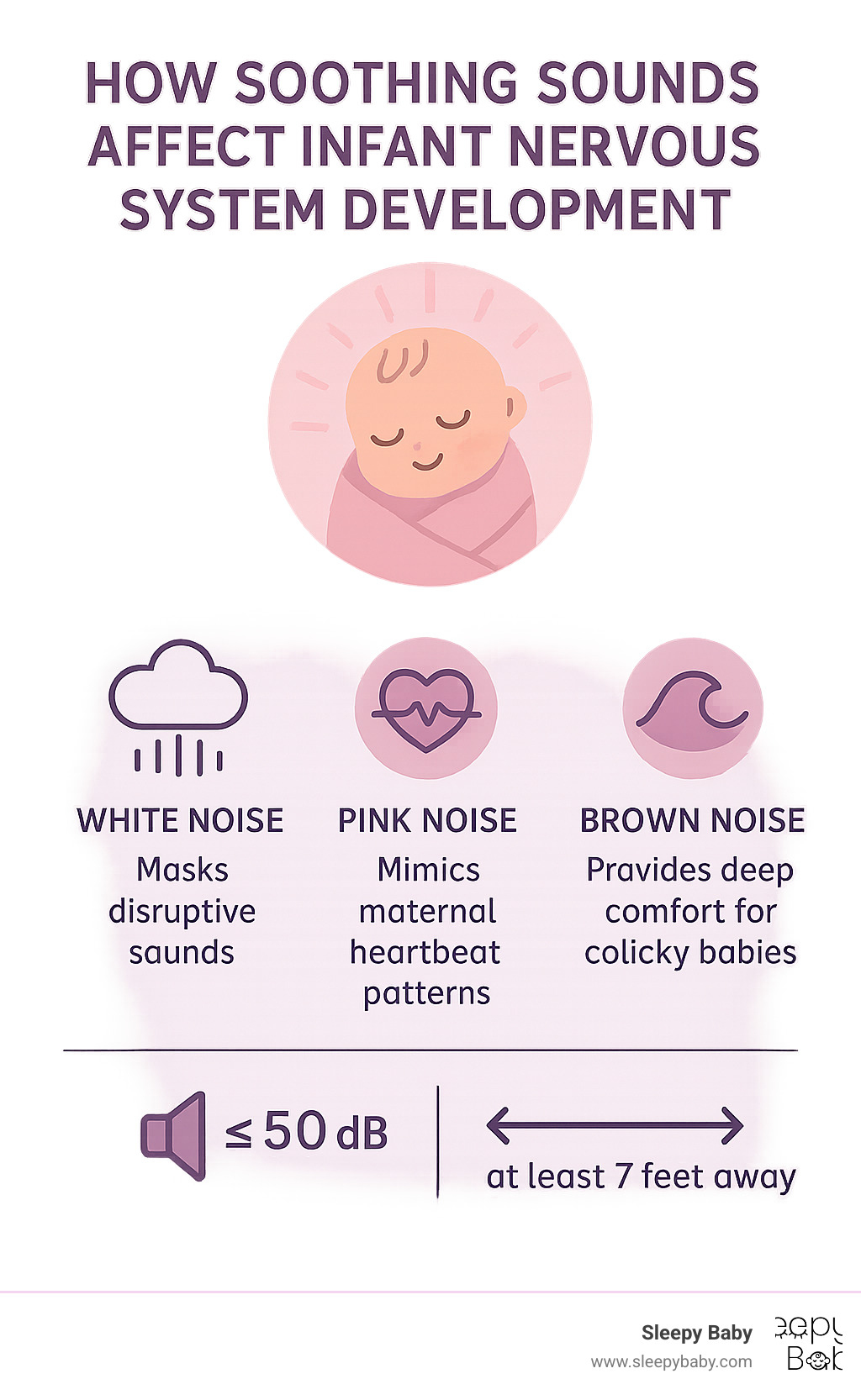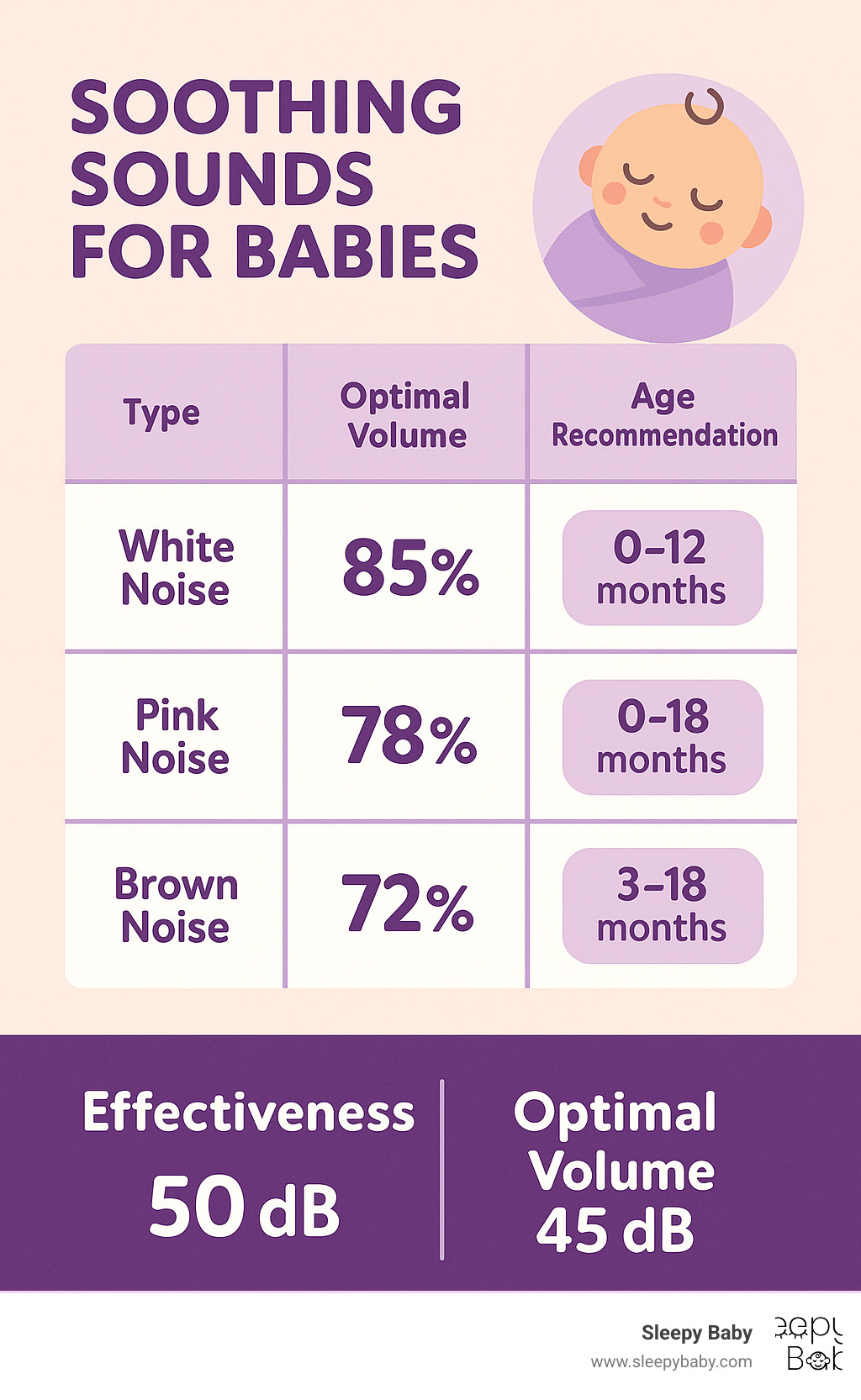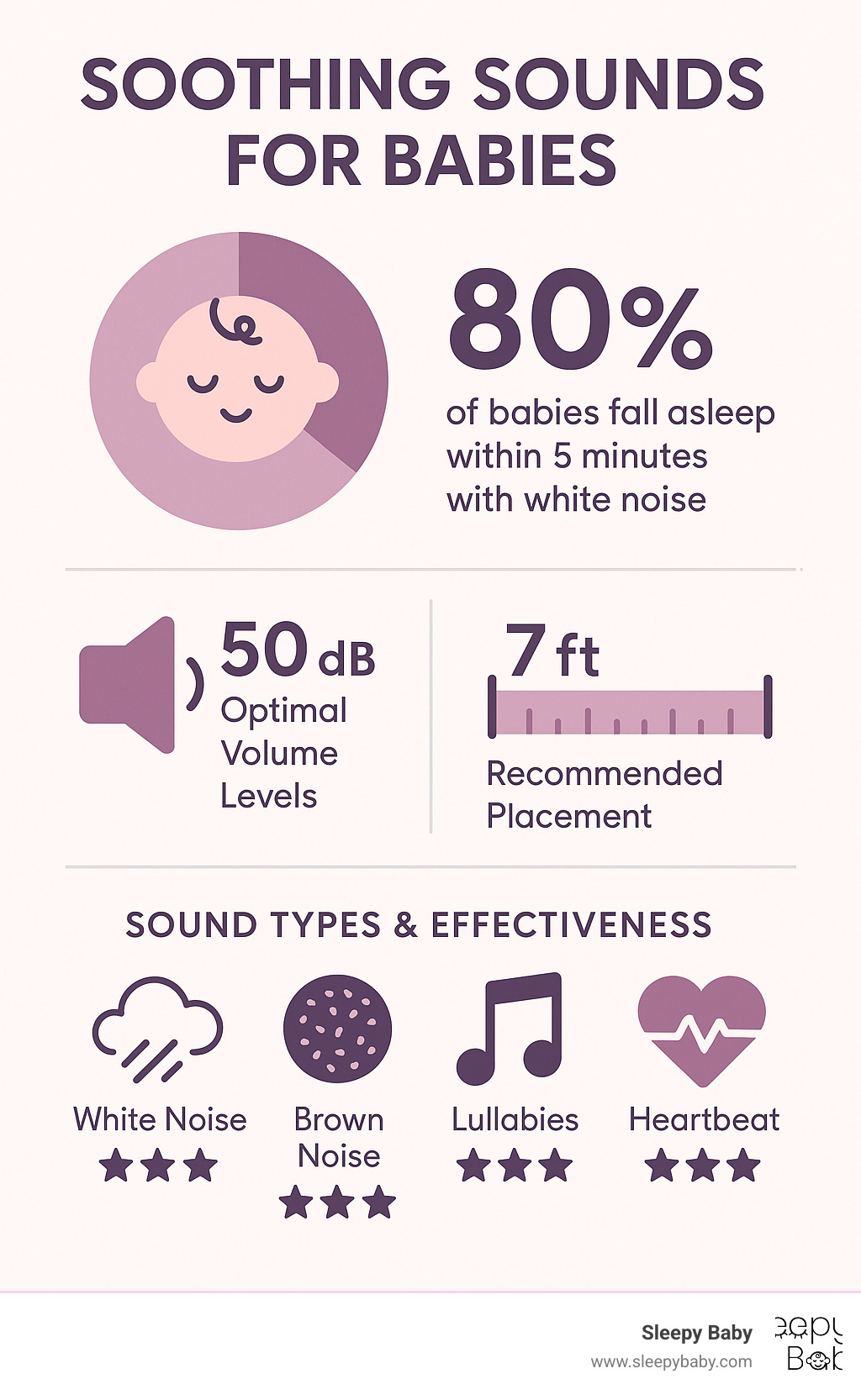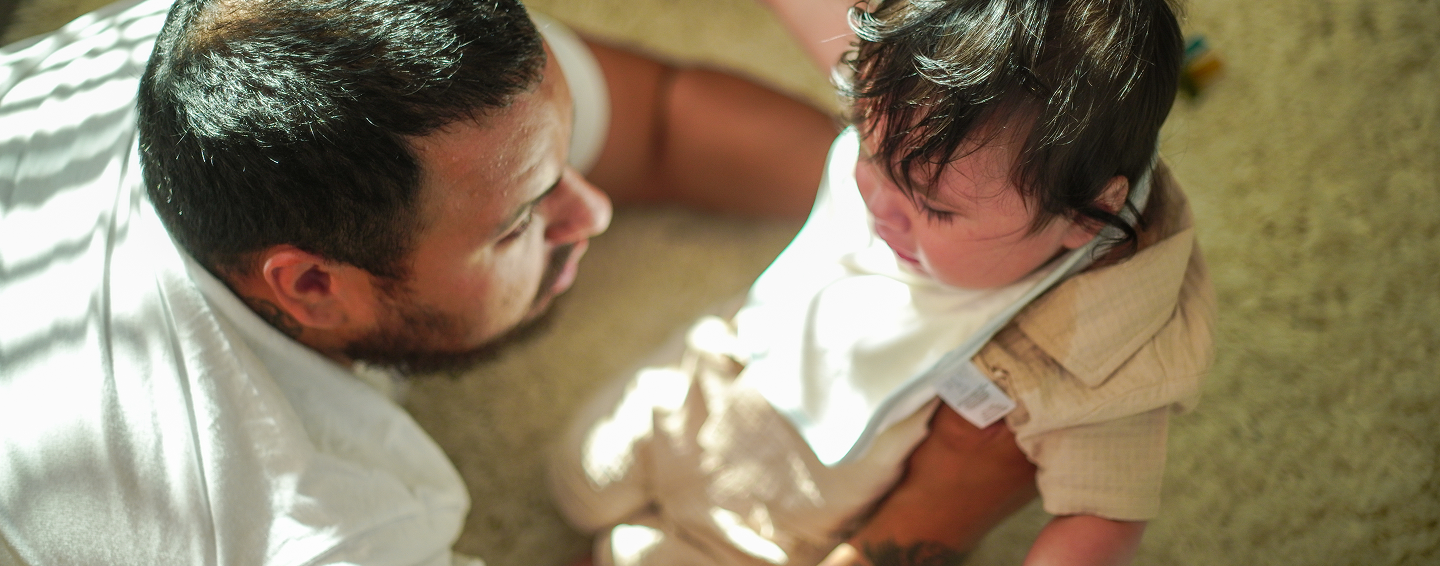Why Soothing Sounds Help Babies Sleep Better
Soothing sounds for babies can be a game-changer for exhausted parents dealing with sleepless nights and fussy infants. Research shows that 80% of newborns fell asleep within five minutes when exposed to white noise, making sound-based solutions one of the most effective tools in your parenting toolkit.
The most effective soothing sounds for babies include:
- White noise - Vacuum-like hum that masks disruptive sounds
- Pink noise - Rainfall and ocean waves that mimic heartbeat patterns
- Brown noise - Deep, low-frequency sounds like waterfalls
- Nature sounds - Birdsong, wind, and gentle water flows
- Lullabies - 60-80 BPM music that naturally calms infants
- Heartbeat sounds - Womb-like rhythms babies recognize from birth
- Shushing - Parental voice patterns that trigger relaxation
The science is clear: babies spend nine months hearing background noise at 85-95 decibels in the womb. White noise and other soothing sounds recreate this familiar environment, helping infants feel secure and drift off faster.
But here's what many parents don't know - volume and placement matter enormously. The American Academy of Pediatrics recommends keeping sound machines at 50 decibels or lower and placing them at least seven feet from your baby's ears.
As a new father who struggled through countless sleepless nights, I'm Gary Harutyunyan, and my personal battle with my newborn's sleep challenges led me to develop the Sleepy Baby - combining soothing sounds for babies with gentle rhythmic patting. My experience as a bureau chief managing complex projects gave me the skills to create a solution that brings rest to families worldwide.

Top 10 Soothing Sounds for Babies (With Science!)
Finding the right soothing sounds for babies doesn't have to feel like guesswork. Science has given us clear answers about which sounds work best and why they're so effective at calming fussy infants and promoting better sleep.
White Noise Wonders
White noise stands as the champion of infant sleep aids, and there's solid research backing up what millions of parents have finded. This steady, vacuum-like hum works through something called "auditory masking" - essentially creating a sound barrier that prevents sudden noises from startling your baby awake.
The numbers speak for themselves. In landmark research, 80% of newborns fell asleep within five minutes when exposed to white noise, compared to much lower success rates without it. The magic happens because white noise recreates the constant whooshing sounds your baby heard for nine months in the womb.
You'll find white noise in everyday sounds like vacuum cleaners, hair dryers, fan noise, and air conditioner hums. The key is that consistent, unchanging quality that wraps around your little one like an invisible blanket of calm.

Pink Noise Calm
Pink noise might sound technical, but you've been hearing it your whole life. Unlike white noise's even intensity across all frequencies, pink noise emphasizes lower frequencies while softening higher ones. The result? Beautiful sounds like gentle rainfall, ocean waves, and rustling leaves.
Here's what makes pink noise special for babies: heartbeat patterns in the womb actually behave like pink noise. This means these sounds feel deeply familiar to newborns from day one. Research shows babies respond to pink noise with visible relaxation signs, including decreased heart rate and calmer breathing.
Think of steady rainfall, ocean waves lapping the shore, wind through trees, and gentle waterfalls. These natural pink noise sources have been soothing humans long before we understood the science behind why they work so well.
Brown Noise Hugs
Brown noise takes the low-frequency emphasis even further, creating deep, rumbling sounds that many parents describe as giving their babies "sonic hugs." These waterfall-like tones can be particularly helpful for colicky infants who seem inconsolable with other sound types.
Studies suggest brown noise's ultra-low frequencies may help regulate breathing patterns and reduce cortisol levels in stressed babies. While research is still developing, countless parents report that brown noise works when nothing else will - especially during those tough evening fussy periods.
You'll recognize brown noise in deep waterfall recordings, gentle thunder rumbles, large river flows, and heavy rainfall on rooftops. The deeper, more enveloping quality makes some babies feel extra secure and protected.
Nature's Lullabies
Mother Nature created the original soothing sounds for babies long before we invented sound machines. Natural soundscapes offer richness and variety that electronic sounds sometimes lack. Field recordings from forests, beaches, and meadows provide complex audio environments that can both engage and calm infant minds.
Research shows babies respond positively to authentic nature recordings, possibly because these sounds signal safety and tranquility at a primal level. Plus, introducing natural sounds early might foster a lifelong love of the outdoors.
Morning birdsong, wind through pine forests, gentle ocean surf, babbling brooks, and soft rain on leaves all create that perfect backdrop for peaceful sleep. Many parents find that rotating between different nature sounds keeps their baby interested and prevents habituation.
Classic Lullabies & Gentle Music
Music holds special power in infant development that goes beyond just promoting sleep. Research reveals that babies respond to lullabies regardless of language, showing signs of relaxation even when hearing foreign songs. The secret ingredient? Tempo of 60-80 beats per minute that naturally synchronizes with resting heart rates.
A fascinating 2022 study found that newborns experienced decreased heart rates when listening to happy music, but showed no response to sad music or silence. This tells us that musical content matters just as much as tempo.
One historically significant contribution deserves special mention: Raymond Scott's Soothing Sounds for Baby, Vols. 1-3. Created with the Gesell Institute of Child Development in 1962, this three-volume electronic music series was specifically designed for infants at different developmental stages. While critics initially dismissed it, modern parents and ambient music enthusiasts have refinded its remarkable effectiveness.
The most effective musical elements include simple, repetitive melodies with soft instrumentation, familiar lullaby tunes, and especially parental singing voices. Your own voice, even if you think you can't carry a tune, remains one of the most powerful tools in your soothing arsenal.
Heartbeat & Womb Sounds
Perhaps no sound is more fundamentally comforting to a newborn than the rhythmic beating of a heart. After spending nine months listening to mom's cardiovascular system, these sounds represent the ultimate in safety and security.
Womb sound recordings often combine heartbeats with the muffled whooshing of blood flow and digestive sounds. These complex audio environments recreate your baby's first home with remarkable accuracy, which explains why they're so effective at triggering instant calm and promoting faster sleep onset.
The most effective heartbeat sounds maintain steady 60-80 BPM rhythms, sometimes combined with gentle breathing sounds or synchronized with soft music. Some recordings even feature variable tempo heartbeats that gradually slow down, naturally guiding your baby toward sleep.
Parental Shushing & Voice Recordings
Never underestimate the power of your own voice. Parental shushing creates rhythmic, soothing sounds that babies associate with comfort and care. The beauty of voice-based soothing? It's completely portable - you always have it available, no batteries required.
Some clever parents create loopable recordings of their own shushing or gentle humming for times when they need hands-free soothing. Research confirms that familiar voices trigger stronger relaxation responses than unfamiliar ones, making these personalized recordings particularly powerful.
Rhythmic "shush-shush-shush" patterns, gentle humming, soft singing, whispered reassurances, and recorded bedtime stories all tap into your baby's deep need for parental connection. The combination of familiar voice tones with repetitive patterns creates an incredibly effective soothing tool that costs nothing but works wonders.
The Science Behind Soothing Sounds for Babies
Ever wonder why your baby seems to sleep better in a noisy coffee shop than in a perfectly quiet nursery? The answer lies in understanding your little one's first nine months of life. Soothing sounds for babies work so well because they recreate the surprisingly loud world your baby called home before birth.
Inside the womb, your baby experienced constant background noise at 85-95 decibels - about as loud as city traffic or a busy restaurant. This wasn't just random noise, though. It was a complex symphony of heartbeats, blood flow, digestive sounds, and muffled voices that became your baby's definition of normal and safe.
When babies are born into our relatively quiet world, the sudden silence can actually feel unsettling. Scientific research on infant white noise shows that recreating these familiar prenatal soundscapes helps newborns feel secure and transition more easily to life outside the womb.
The research is pretty remarkable. Studies tracking infant sleep patterns reveal that babies exposed to appropriate background sounds experience reduced cortisol levels (that's the stress hormone), improved neural development, and significantly longer sleep periods. It's like giving your baby a sonic security blanket.
Why White Noise Works
White noise works through a fascinating process called auditory masking. Imagine your baby's hearing as a busy telephone operator from old movies - when consistent background sound fills all the "lines," sudden noises like door slams or dog barks can't get through to startle your sleeping infant.
But here's where it gets really interesting: white noise doesn't just block disruptive sounds. Research using brain monitoring equipment shows that babies exposed to appropriate white noise actually spend more time in deep, restorative sleep stages. This is the sleep that's crucial for brain development and growth hormone release.
Scientists have finded that white noise triggers something called brainwave entrainment. Basically, your baby's brain activity starts to sync up with the rhythmic sound patterns, naturally regulating their sleep-wake cycles. It's like having a gentle conductor helping orchestrate better sleep.
The sleep latency - that's how long it takes to fall asleep - drops dramatically with white noise. Study showing 80% of newborns fell asleep within five minutes? That's the power of auditory masking and brainwave entrainment working together.
Music & Development
Music does something magical for developing brains that goes way beyond just helping babies fall asleep. When we look at the research on infant music exposure, the benefits are pretty amazing for language skills, heart rate response, and overall cognitive development.
Here's something that blew my mind when I first learned it: babies who regularly hear lullabies and gentle music actually develop stronger neural pathways for processing language. The rhythmic patterns in music mirror speech patterns, helping tiny brains learn to recognize cadence, tone, and emotional content in human voices.
As we explore in White Noise in the Womb: Your Baby's First Lullaby, your baby's musical journey begins months before their first breath. Research shows that newborns can actually distinguish between happy and sad music, with measurable heart rate decreases when they hear gentle, upbeat melodies.
The developmental benefits stack up beautifully: improved emotional regulation as babies learn to associate certain sounds with comfort, stronger parent-child bonding during musical moments, and better overall sleep quality that supports healthy growth. Even more fascinating, early musical exposure appears to give babies a head start on language development, helping them recognize patterns and rhythms that will later become the building blocks of speech.
It's like giving your baby's developing brain a gentle workout while they sleep - pretty incredible when you think about it.
Safe & Smart Usage: Volume, Duration, Dependency
While soothing sounds for babies offer tremendous benefits, safety must come first. The American Academy of Pediatrics provides clear guidelines that every parent should follow to protect their infant's developing hearing.
Picture this: you've finally found the perfect white noise that sends your little one off to dreamland in minutes. But here's the thing - even the most effective sound can become harmful if used incorrectly. The good news? Following a few simple safety rules ensures your baby gets all the benefits without any risks.

Setting the Right Volume
The 50 dB rule isn't some random number pulled from thin air - it's based on extensive research into how infant hearing develops. Think of 50 decibels as the sound of a soft shower or a quiet conversation in the next room. It's gentle enough to soothe without overwhelming those tiny, sensitive ears.
Here's a reality check that might surprise you: many parents accidentally set their sound machines too loud. What sounds reasonable to adult ears can actually be too intense for babies. That's where the NIOSH SLM app becomes your best friend - this free, government-approved sound meter takes the guesswork out of volume levels.
Position your sound machine at least seven feet away from your baby's crib, then measure the sound level right where your little one's head rests. If you're hitting that sweet spot around 50 decibels, you're golden. Never, ever exceed 80-90 decibels - that's when permanent hearing damage becomes a real concern.
Distance is your ally here. The further away you place the sound source, the gentler it becomes by the time it reaches your baby's ears.
How Long to Play Each Sound
Here's where many well-meaning parents go overboard. Just because a sound works beautifully doesn't mean it should play all night long. Think of soothing sounds for babies as a sleep aid, not a sleep crutch.
The magic window is typically 20-30 minutes during initial sleep onset. This gives your baby enough time to settle into deeper sleep stages while avoiding over-dependence. Many parents find success with gradual fade-outs - starting at a comfortable volume and slowly decreasing over 15 minutes until the sound disappears entirely.
Timer-based automatic shutdown becomes incredibly helpful here. You can set it and forget it, knowing the sound will gently fade away once your baby has transitioned into stable sleep. This approach respects your baby's natural sleep cycles while still providing that initial comfort boost.
Consistency in timing matters too. If you always start the bedtime routine with sounds at 7 PM, your baby's internal clock begins anticipating and preparing for sleep at that time.
Avoiding Over-Reliance
Let's address the elephant in the room: "Will my baby become addicted to sound machines?" While babies can't develop true addiction to sounds, they absolutely can become dependent on them. The difference? Dependency makes sleep difficult without the familiar audio cues, but it's completely reversible with patience.
The key is building self-soothing skills alongside sound-based comfort. Think of it like training wheels on a bicycle - helpful at first, but eventually your little one needs to develop balance independently. This means occasionally skipping the sound aids, even if bedtime takes a bit longer.
Gradual weaning strategies work best for most families. Start by reducing volume slightly each week, or skip sounds during daytime naps while keeping them for nighttime. Some parents introduce variety by rotating between different sound types, preventing over-attachment to any single audio cue.
The beautiful thing about proper sound usage is that it actually supports independence rather than hindering it. When used correctly, soothing sounds for babies help establish consistent sleep patterns that eventually become self-sustaining. Your baby learns to associate certain cues with sleep time, making the transition to independent sleep smoother and more natural.
Every baby is different. Some naturally wean themselves off sound aids, while others benefit from more structured reduction plans. Trust your instincts and don't rush the process - healthy sleep habits develop over months, not days.
Building a Sound-Sleep Routine
Creating a bedtime routine with soothing sounds for babies doesn't happen overnight, but once you find your rhythm, it transforms those chaotic evenings into peaceful transitions. The secret lies in consistency - babies thrive on predictable patterns that signal sleep time is coming.
Think of your routine as a gentle staircase leading down to dreamland. Most successful parents follow a simple sequence: feed, bathe, activate sounds, and settle. This progression naturally lowers your baby's energy and prepares their nervous system for rest.

The magic happens when your little one starts recognizing these cues. After a few weeks, simply turning on their familiar white noise or nature sounds can trigger sleepiness. It's like having a gentle switch that tells their brain, "Time to wind down now."
Caregiver consistency matters enormously here. Whether it's mom, dad, or grandma handling bedtime, everyone should follow the same sequence. Babies notice when routines change, and inconsistency can undo weeks of progress.
Tech That Helps (and When)
Modern sleep aids have come incredibly far from simple sound machines. Hands-free devices offer something parents didn't have generations ago - consistent, reliable soothing that doesn't depend on your energy level after a long day.
Our Sleepy Baby device combines gentle rhythmic patting with customizable soothing sounds for babies, creating what many parents describe as "having an extra pair of hands." The rhythmic motion mimics a caregiver's comforting touch while delivering the familiar audio environment your baby craves.
What makes intelligent sleep aids particularly valuable is their predictability. Unlike manual soothing, which naturally varies based on how tired you are, automated systems deliver the exact same comforting experience every single time. This consistency helps babies develop stronger sleep associations faster.
When shopping for sleep technology, look for multiple sound options so you can find what works best for your unique baby. Volume control and timer functions are essential for safe usage, while portable design means you can maintain routines whether you're home or traveling.
Battery backup can be a lifesaver during power outages or when visiting relatives. Easy nighttime operation - buttons you can find in the dark - saves you from fumbling around and potentially waking a settling baby.
For a comprehensive look at how different sleep aids work together, check out our guide Dreamland Awaits: Your Guide to Infant Sleep Aids.
DIY & Low-Cost Options
Not every family needs expensive technology to create effective sound routines. Some of the best solutions cost practically nothing and work beautifully for years.
Smartphone apps have revolutionized budget-friendly baby soothing. Many offer extensive libraries of white noise, nature sounds, and lullabies with built-in timer functions. The key is finding apps that work offline - you don't want your baby's sleep depending on internet connectivity.
Streaming service playlists work wonderfully if you already subscribe to music platforms. Create custom playlists of gentle sounds and set them to repeat. Just remember to put your phone on airplane mode to avoid notification disruptions.
Household fans or air purifiers provide natural white noise while serving practical purposes. Many parents swear by the consistent hum of a ceiling fan or the gentle whoosh of an air filter. These solutions run quietly all night without timers or batteries.
DIY recordings of your own voice create deeply personal soothing experiences. Record yourself humming, shushing, or singing lullabies, then loop the audio for consistent playback. Babies often respond more strongly to familiar voices than generic recordings.
The most important factor isn't how much you spend on soothing sounds for babies, but how thoughtfully you integrate them into a loving, consistent bedtime routine. Whether you choose high-tech solutions or simple household items, your baby will benefit from the security of predictable, comforting sounds that signal safety and sleep time.
Frequently Asked Questions about Soothing Sounds for Babies
Can my baby's hearing be damaged by white noise?
Yes, if used improperly. Sounds above 80-90 decibels can damage infant hearing, but staying at or below 50 dB with proper placement (7 feet away) makes white noise completely safe. Babies experienced 85-95 dB in the womb, so appropriate sound levels actually recreate familiar conditions.
Use a sound meter app to verify levels, and trust your instincts - if it sounds too loud to you, it's definitely too loud for your baby.
Will my baby get addicted to sound machines?
Physical addiction isn't possible, but dependency can develop. To prevent this, use sounds as part of routines rather than continuous overnight playback. Gradually reduce volume over time and occasionally skip sound aids to encourage natural self-soothing skills.
Most babies naturally outgrow their need for sleep sounds as their nervous systems mature, typically between 6-12 months.
Which sound type is best for colicky nights?
Brown noise and heartbeat sounds often work best for colicky babies. The ultra-low frequencies in brown noise may help regulate breathing and reduce stress hormones. Womb sounds with heartbeats recreate the ultimate comfort environment.
However, every baby is different. We recommend trying various sound types during calm periods to identify your baby's preferences before colicky episodes strike.

Conclusion
Soothing sounds for babies represent one of the most effective, science-backed tools available to exhausted parents. From white noise's proven 80% success rate in promoting quick sleep onset to the developmental benefits of gentle lullabies, audio-based solutions offer real help for real families.
The key to success lies in safe, consistent application. Keep volumes at 50 decibels or below, maintain proper distance, and use sounds as part of broader bedtime routines rather than standalone solutions. Every baby is unique - what works for one infant may not work for another, so patience and experimentation are essential.
As we've learned through our own parenting journeys and the development of Sleepy Baby's intelligent sleep aids, combining multiple soothing elements often proves most effective. Rhythmic patting paired with gentle sounds mimics the multi-sensory comfort babies experienced in the womb.
Whether you choose high-tech solutions or simple smartphone apps, the goal remains the same: helping your baby feel secure, comfortable, and ready for the restorative sleep that supports healthy development. For more guidance on creating the perfect sleep environment, explore our comprehensive resource on Naturally Restful: Best Sleep Aids for Infants.
Sweet dreams start with the right sounds, proper safety practices, and lots of love. Your journey to better sleep for the whole family begins with understanding that soothing sounds for babies aren't just nice to have - they're powerful tools backed by decades of research and millions of success stories from families worldwide.




